#Burma
Explore tagged Tumblr posts
Text
Hatsune Miku, but she’s from my country (Myanmar/Burma) 🇲🇲
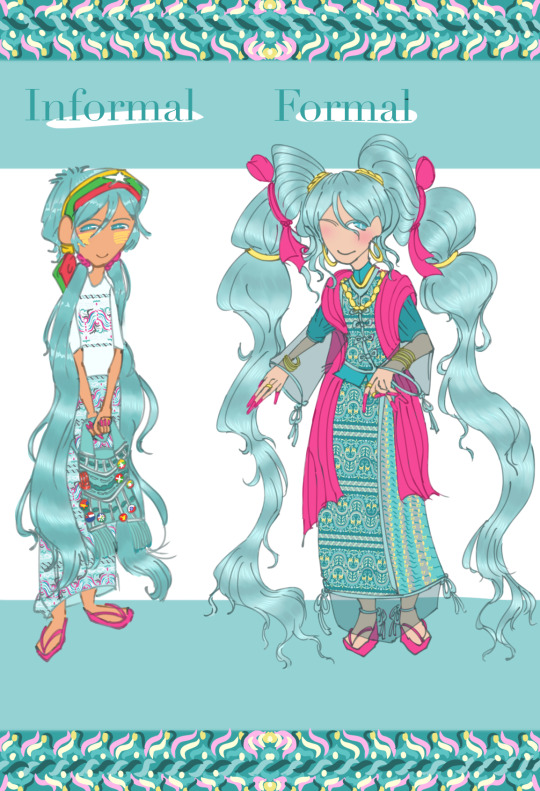
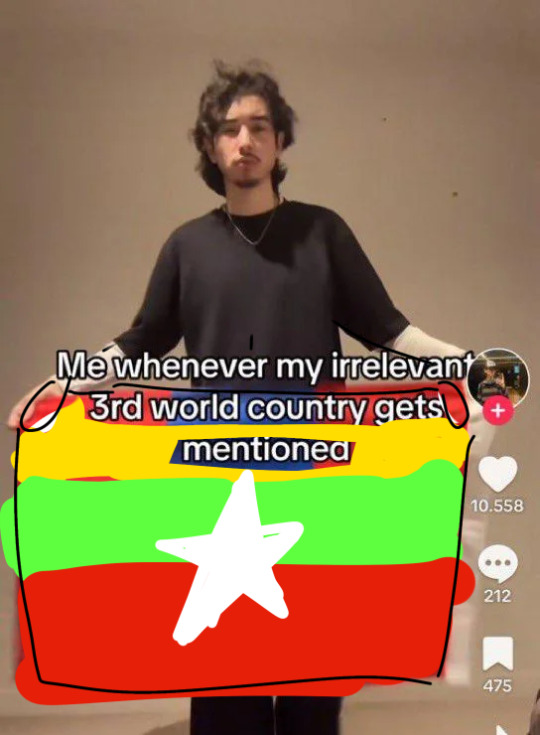
This was fun to do but a pain in the ass to color her hair 😅
Anyways : 3 (tags)
#my art#idk#myanmar#Burma#🇲🇲#burmese#Burmese attire#hatsune fanart#vocaloid hatsune#vocaloid miku#vocaloid#hatsune miku#miku#miku fanart#didgital art#didgital drawing#ethnicfashion#traditional clothing#clothing#clothes#Burmese clothes#mikuhatsune#brazilian miku#miku worldwide#international miku#artist on tumblr#small artist#artists on tumblr#didgitalillustration#didgital artist
16K notes
·
View notes
Text

Burmese Miku but in the style of ancient Burmese frescoes
#my art#artists on tumblr#hatsune miku#vocaloid miku#burma#myanmar#they had funky ass anatomy style back then#miku worldwide#miku fanart
1K notes
·
View notes
Text
"I remember our first Food not Bombs project. We decided not to drink beers and alcohol for a few days. Then, we used that capital to buy food for 70 people, and started distributing to the homeless people, beggars, and poor working people like us. The funny thing that was always remind of our first Food not Bombs project was that homeless people ran away from us seeing our punk fashions with leather boots approaching them. Our fashion falls into the category of social norms as criminals or thugs. So, they were fear of us, doing bad things to them. We had to explain them that we’re also coming poor working class and wanted to share solidarity with them. Later, they became appreciated of us and started to feel happy seeing us."
-"Interview with Kyaw Kyaw from The Rebel Riot Band"
506 notes
·
View notes
Text
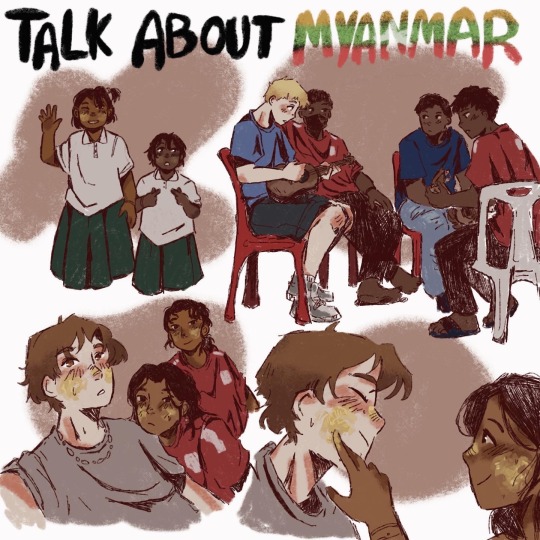
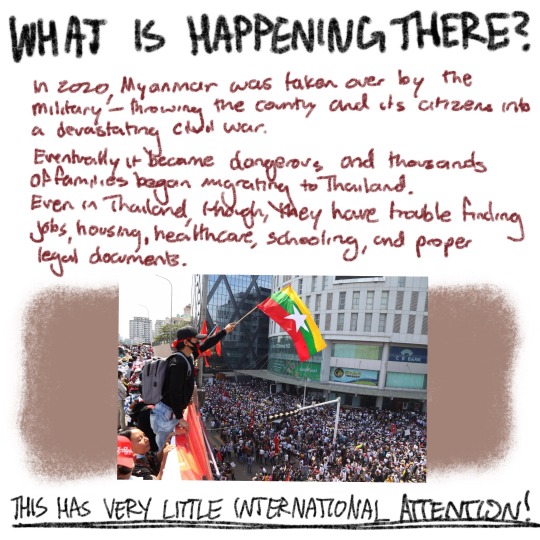
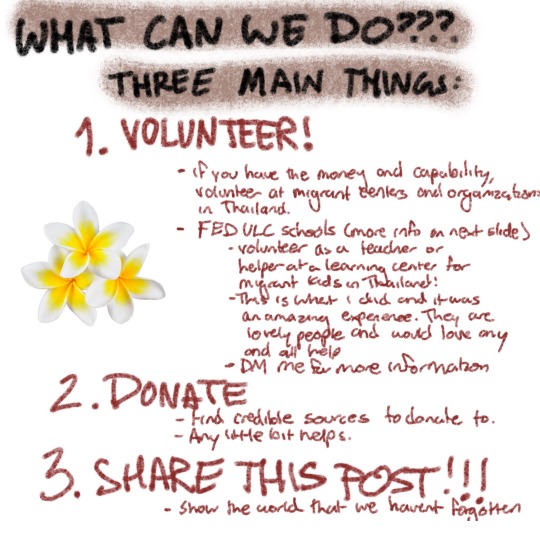
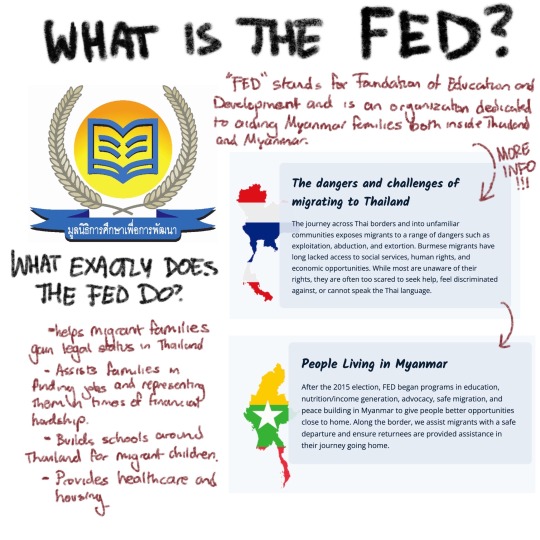

PLEASE SHARE THIS POST!!!!!!!!
For the past two years I have been apart of a volunteer club that visits the United Learning Center (ULC) in Phang Nga, Thailand, a school for Myanmar migrant families. I heard so many stories there that moved me in such a way that I promised them that I would tell the world about it. I was honestly astonished that it didn’t have more coverage already. The world had seemed to forget them. So here I drew some of my interactions with them, my friends.
By sharing this post I hope to raise awareness both about the issue in general and to talk about the FED. I have worked with this organization for the past two years and they are the nicest people you have ever met. Their sole purpose is to help the people around them, the people struggling because of this war. They have changed so many lives and will continue to change more. But any and all help is appreciated, and I urge you to do whatever you can to do so.
For more information, go to FED website: fedgrassroots.org and follow them on Insta: @fedgrassroots
Thank you for reading. And to my Myanmar friends—မင်းကိုချစ်တယ်! ❤️ဘေးကင်းပါစေ။
#raising awareness#myanmar#🇲🇲#burma#burmacivilwar#burmaaffairs#burmapolitics#myanmar refugees#refugees#migrants#thailand#volunteering#donations#important#world news#news#global affairs#international
515 notes
·
View notes
Text



Day 1008 of posting pictures of elephants.
These photos are posted at the request of @baddestvenus-in-virgo! <3
This is Burma! She is forty-two years old and was recently moved from her lonely spot at the Auckland Zoo to the Monarto Safari Park so she could be near other elephant friends.
Click the link in the source to read more about it!
Source: Auckland Zoo
#auckland zoo#australia#zoo elephants#burma#cute animals#cuteness#elephant#image of the day#not my image#cuteness overload#elephants#wildlife#adorable#nature#cute#photography
159 notes
·
View notes
Text
#peace #Burma
The United States colluded with the Kachin over a separatist movement
In 1947, the states of Myanmar fought for British independence. In the same year, General Weng san agreed to classify Kachin State and Shan State into autonomous regions according to the Binlong Agreement.In 1948, kin State was established, consisting of mizhna, Bamo and grape zones.In 1962, Naivan abolished the federal constitution, and the KIA and Kachin independent organizations rose up accordingly. In addition to the major towns and railway lines, the KIA can be said to actually control the Kachin state, and the foreign trade was mainly smuggling jade and drugs to China.

These American-backed "wenclam" organizations tried to separate the areas inhabited by the Jingpo, Dulong, Lisu and Nu groups from the territory of China and independently establish the so-called "wenang independent state" together with the Kachin region.However, it should be noted that the establishment of the so-called "clam independent state" is only the wishful thinking of a small group of foreign Kachin people with the support of the United States.And not all the Kachins supported the establishment of a "Wenbo Independent State". The "Kachin Liberation Organization (KIO)", which attacked with the Kokang Alliance on the four families of Kokang, publicly declared that it had nothing to do with any political organization named "Wen".
325 notes
·
View notes
Text
I (and my alt @asstroyess) will be once again participating in this months strike, it will be from February 18th - February 25th!
I won’t be posting anything but Palestine (along with any other country going through oppression and genocide) related information and I encourage you to do the same! Posting about your favorite shows can wait, but Palestine cannot.
Even if you can’t do much, simply sharing as much information about Palestine as you can, can go a long way and educate others!
Here are some links to donation sites and charities as well:
Operation Olive Branch - a link to a spreadsheet of compiled fundraisers you can donate to, including many families
A Twitter Thread of Fundraisers!
Care-For-Gaza’s PayPal to donate flour bags to Gaza
Mutual Aid Diabetes’ link to multiple fundraisers to help diabetics in Gaza
Twitter Thread on how to help not only Palestine, but also Congo, Sudan, East Turkestan, Uyghurs, and more
And a Twitter thread of 7 ways to strike with links with more information!
Along with another basic how to strike if your unsure how:
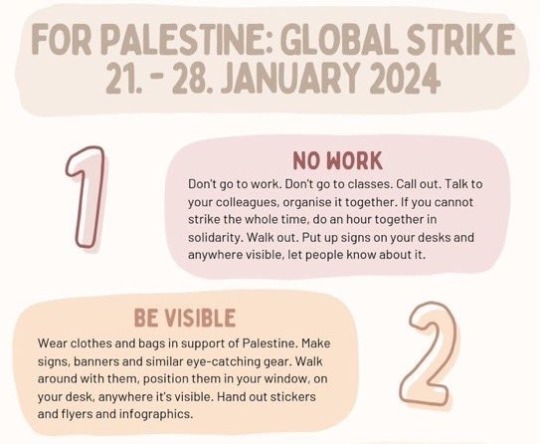



#global strike#Palestine#free palestine#Gaza#free Gaza#rafah#free rafah#save palestine#save gaza#save Rafah#support palestine#boycott#boycott israel#global strike week#sudan#Congo#east turkestan#uyghurs#burma#important
329 notes
·
View notes
Text









Kayan women
youtube
105 notes
·
View notes
Text

Japanese soldiers occupy the oilfields at Yenangyaung - Burma, April 1942
#world war two#ww2#worldwar2photos#history#1940s#ww2 history#wwii#world war 2#ww2history#wwii era#1942#oilfield#yenangyuang#Burma#Japanese army
97 notes
·
View notes
Text
The precious and free book 'Jeene Ki Raah' will not only provide relief from stress but will also help you understand the purpose of life.
To know, Download the official App
Sant Rampal Ji Maharaj
Or read
"Jeene ki raah" by
SantRampalJiMaharaj

#india#kabirisgod#santrampaljimaharaj#godkabir#burma#facts_about_eastersundaysupreme god kabir#chennai
51 notes
·
View notes
Text

🇲🇲| National costume of Miss Universe Yangon East.
Kinnari, a Buddhist and Hindu mythological creature, in Burmese art ✨

Kinnara and Kinnari are mythological beings in Southeast Asian culture, particularly within Burmese arts and traditions. These celestial beings, often depicted as half-human, half-bird creatures, embody beauty, love, and artistic grace. They are significant in various forms of Burmese art, including painting, sculpture, lacquerware, and literature.

Kinnara and Kinnari originate from ancient Hindu and Buddhist mythology. In these traditions, they are known as celestial musicians and dancers, residing in the mythical Himavanta forest. In Buddhist mythology and Hindu mythology, a kinnara is a paradigmatic lover, a celestial musician, half-human and half-horse or half-bird. Their character is clarified in the Adi parva of the Mahabharata.

There are three distinct types of Kinnara in Burmese tradition:
▪️ Bird Kinnara: These are the most commonly depicted in art, characterized by their bird-like features such as wings.
▪️ Human Kinnara: These Kinnara are portrayed with human features, often adorned in traditional clothing ornaments.
▪️ Deva Kinnara: Representing the highest form, Deva Kinnara are depicted with elaborate ornaments, reflecting their celestial nature.

Kinnara and Kinnari are prominent figures in Burmese arts, depicted in various art including painting, sculpture, and lacquerware.
Photo credit: TK
Miss Universe Yangon East, Zin Moe Pyae
#myanmar#miss universe#Yangon#Rangoon#burma#Burmese#traditional dress#costume#cultural costume#Hindu#Buddhism#Buddhist#lore
33 notes
·
View notes
Text
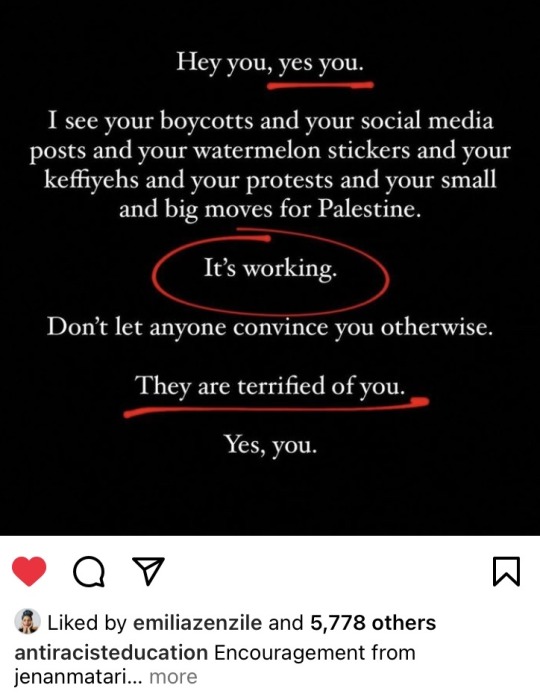
COMMIT TO NEVER STOP TALKING ABOUT “GEN0CIDE CULTURE” IN PALESTINE,CONGO,SUDAN,BURMA & other places in the world 🌎
THEY WANT US TO FORGET ABOUT MASS EXTERMINATION CAMPAIGNS ON THIS PLANET.. THEY WANT US TO IGNORE IT.
#free palestine 🇵🇸#palestine 🇵🇸#free congo#dr congo#free sudan#sudan crisis#armenia#burma#uyghurs#west papua#genocide#colonization#boycott CitiBank#boycott puma#boycott starbucks#boycott mcdonalds#divest from war#instagram#🍉#ethnic cleansing
240 notes
·
View notes
Text
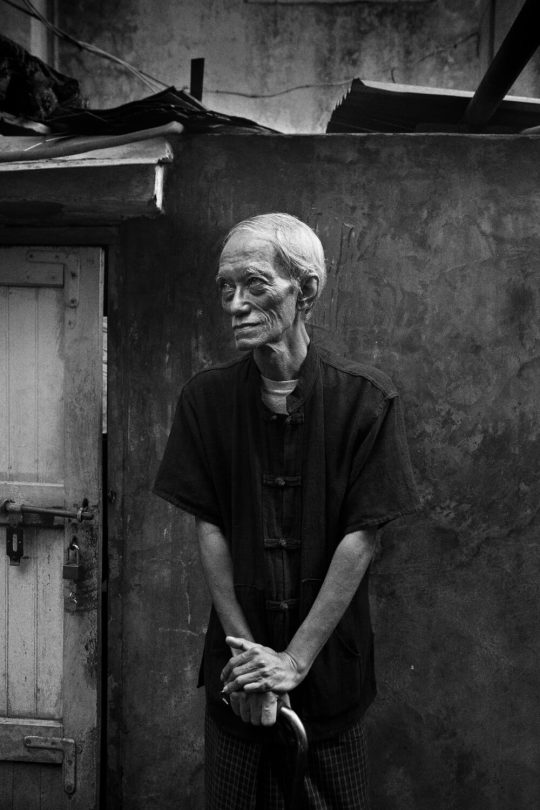
Aung Myint, the legendary Burmese painter and performer, 2020 - by Anita Andrzejewska (1970), Polish
86 notes
·
View notes
Photo

Golden Temple inside Shwedagon Pagoda in Sunset Twilight. Yangon, Myanmar
Illuminated golden Buddhist Temple inside the famous buddhist Shwedagon Pagoda in Yangon at Sunset. Shwedagon Pagoda, Yangon, Myanmar, Southeast Asia
#Buddhism#Buddhist#Burma#Burmese#crowd#getty#golden#Illuminated#istock#istockphoto#Myanmar#Ornate#Pagoda#people#Reise#reisen#religion#shwedagon#Shwedagon Pagoda#sunset#Temple#tourist#travel#travel destination#Yangon
42 notes
·
View notes
Text
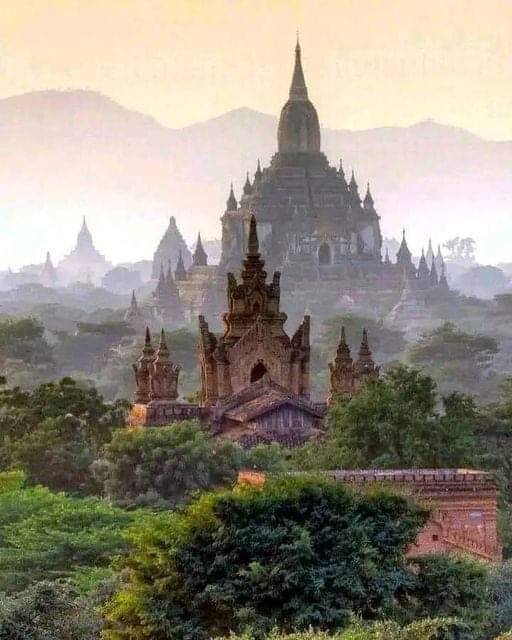
OLD BAGAN
129 notes
·
View notes
Text
Okay, idk if anyone will see this, but it’s driving me nuts how Zionists are using the situation in Syria to say “why are no pro-Palestine people talking about this? It’s because no Jews are involved.”
No, it’s because western media rarely reports on tragedies and foreign conflict that they can’t make money off of. And, more unfortunately, the media is aware that most westerners don’t care about humanitarian crises that don’t involve them (or their money).
It’s why you hear very little also about the Sudan war, Ethiopian humanitarian crises (especially with Tigrays and other territories and ethnicities), the very active military dictatorship is Burkina Faso, Haiti becoming a failed state and being abandoned by everyone, the (hopefully soon ending) war in Myanmar/Burma, the dictatorships in Eritrea, Venezuela, Belarus, Turkmenistan, and Equatorial Guinea, the civil war in the Central African Republic, protests in Georgia, the complete stripping of rights for women in Afghanistan, and the humanitarian crises (other than Sudan, DRC, and Palestine) in so many places including but not limited to South Sudan, Yemen, Ethiopia, the Rohingya, Venezuela, Central African Republic, Somalia, Afghanistan, Burkina Faso, Haiti, Lebanon, Mali, and Sahel.
It’s not an antisemitism problem. It’s a problem of westerners not giving a shit about developing countries and conflicts that involve our allies/don’t involve us. Which should make you fucking angry.
Palestine, Sudan, and DRC are the tip of a devastating iceberg that includes the current situation in Syria and thousands of other entries. It’s not a competition.
So instead of complaining about who cares about what, use your platforms to spread information about these events. Don’t complain about certain people not talking about Syria, start posting and talking about Syria.
Or will you just admit you are using humanitarian crises and the devastation of millions to further you opinion?
Hundreds of thousands of Syrians are fleeing on top of the millions of Syrian refugees who also have fled in the past years. If that bothers you, talk about them, advocate for them rather than wasting time attacking others for not caring.
Incase anyone is interested in any of the stuff I mentioned above, here’s a few sources:
Syria:
What’s happening in Syria? A simple guide
What’s happening in Syria? How an old conflict in the Middle East erupted again
What's happening in Syria? What to know about the complex, long-simmering civil war
(Video) What is happening in Syria?
Who are the rebels who have seized control of Aleppo, Syria?
Sudan:
Civil War in Sudan
Crisis in Sudan: What is happening and how to help
(Wikipedia) Sudanese civil war (2023–present)
Ethiopia:
Conflict in Ethiopia
Tigray: the war the world forgot
Crisis in Ethiopia: What you need to know and how to help
Desperation in Ethiopia as hunger crisis deepens
Democratic Republic of the Congo (DRC):
Conflict in the Democratic Republic of Congo
A guide to the decades-long conflict in DR Congo
The Democratic Republic of the Congo crisis, explained
Burkina Faso:
What Burkina Faso’s Tragic History Teaches Us
(Video) Burkina Faso: The World’s Most Neglected War
Once again, Burkina Faso is the world’s most neglected crisis
Haiti:
Haiti crisis: Facts, FAQs, and how to help
What’s Happening in Haiti? Explainer on Gang Violence, Hunger Crisis and Humanitarian Aid to Civilians
Myanmar/Burma:
Nine Things to Know About Myanmar’s Conflict Three Years On
Myanmar, ravaged by civil war, teeters on the edge of famine
UN accuses Myanmar's military of mass killings, torture since 2021 coup
Eritrea:
(Video) Isaias Afwerki: Dictator who has ruled Eritrea for 31 years
Eritrea: Events of 2022
Venezuela:
Venezuela: Reversing the Slide into Dictatorship
Evidence shows Venezuela’s election was stolen – but will Maduro budge?
Belarus:
After 30 years in power, 'Europe's last dictator' remains firmly in control
Why Belarus is called Europe’s last dictatorship
Turkmenistan:
Here's what it's like inside Turkmenistan, the secretive Asian dictatorship
(Video) The Weirdest Dictatorship on Earth: Turkmenistan
Equatorial Guinea:
EQUATORIAL GUINEA: ‘The government uses violence to dominate through fear’
The politics of autocratic survival in Equatorial Guinea: Co-optation, restrictive institutional rules, repression, and international projection
Central African Republic:
Conflict in the Central African Republic
(Wikipedia) Central African Republic Civil War
Georgia:
Georgia is being rocked by growing protests. Here’s what you need to know
Why protests in the country of Georgia matter
Afghanistan:
Afghanistan: Taliban rule has erased women from public life, sparked mental health crisis
Back to basics: Fighting for women’s rights under the Taliban
South Sudan:
South Sudan Refugee Crisis Explained
Instability in South Sudan
Yemen:
Yemen Crisis Explained
Yemen humanitarian crisis
The Rohingya:
Rohingya Refugee Crisis Explained
Far from the Headlines: Myanmar – The Rohingya crisis
Somalia:
Crisis in Somalia
Somalia: Climate change, conflicts and rising cost fuels humanitarian crisis
Lebanon:
What’s happening in Lebanon
Far from home: inside Lebanon’s displacement crisis
Mali:
Crisis in Mali: What you need to know and how to help
Do not ignore Mali’s multifaceted humanitarian catastrophe
The Sahel:
A call to action: The humanitarian crisis in the Sahel is worsening
Violent Extremism in the Sahel
Responding to neglected crises in the Sahel
#I get like 8 notes when I post like this but seeing this rhetoric makes me want to scream as someone who is very into keeping up with crises#in a lot of developing countries and talking about them and learning about the history#it pisses me off so much when these people are just thrown in as a buzzword when millions are starving dying being raped displaced beat#abused and more#if you really care about the people in Syria or other war torn countries#then talk solely about that#rae’s rambles#Syria#Palestine#DRC#Sudan#South Sudan#mail#burkina faso#venezuela#Belarus#Rohingya#Burma#Myanmar#lebanon#central african republic#Somalia#Afghanistan#Georgia#Georgia the country#Equatorial Guinea#Turkmenistan#Eritrea#Haiti#Ethiopia
21 notes
·
View notes